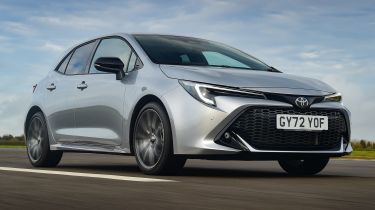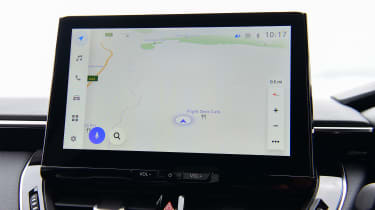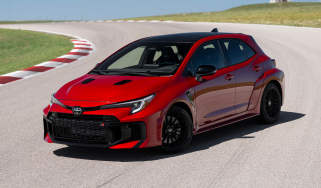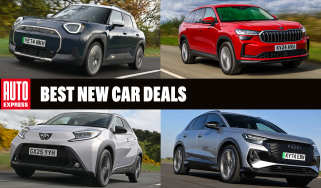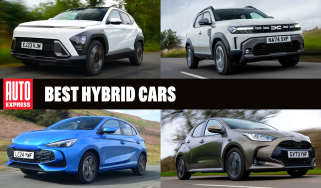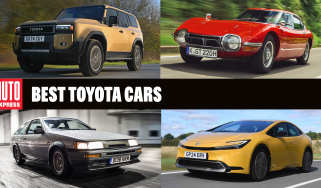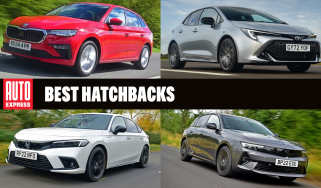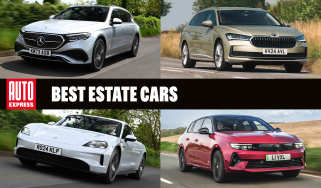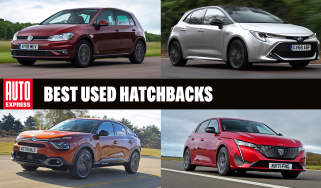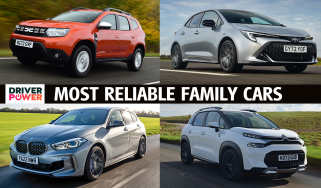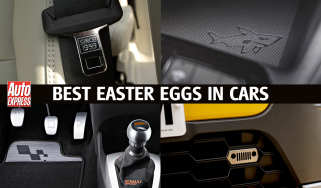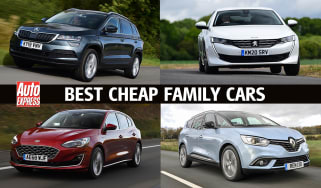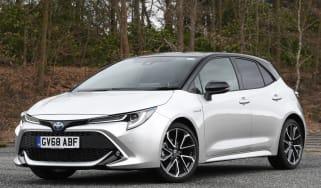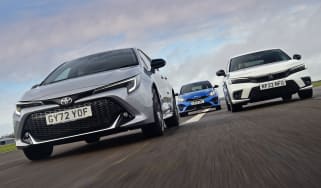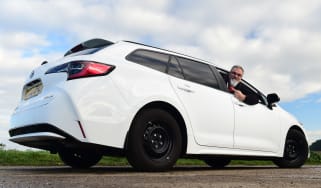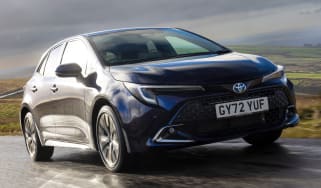Toyota Corolla review
The Toyota Corolla offers impressive efficiency, peerless reliability and an enjoyable drive, but admittedly isn’t the most practical hatchback

The Toyota Corolla no longer leads the family hatchback segment when it comes to practicality but the world’s best-selling car can still hold its own against newer, slicker competition. Thanks to great refinement, a comfortable ride, fantastic build quality and handling that’s precise and controlled – if not the last word in driving pleasure – there’s very little to dislike about the Corolla.
What’s more, this updated model receives subtle improvements to performance with no effect on the car’s impressive efficiency, plus an overhaul of the infotainment system and on-board technology that resolves one of our main gripes with the 12th-generation Corolla. Overall, the British-built hatch is still as solid a family car as ever.
About the Toyota Corolla
The Toyota Corolla has been around in various forms since 1966 and has been the world’s best-selling car for a good portion of its nearly six decades of production. But you don’t get a sales smash just by turning up in the market. The Corolla’s global success is a testament to Toyota’s ability to pinpoint the needs of generations of drivers and deliver the right product to meet them.
We’re now on the 12th-generation Toyota Corolla, which is built in the UK, at the Japanese brand’s Burnaston factory near Derby. This car was refreshed in 2023 with new technology and revised hybrid powertrain.
Used - available now

2022 Toyota
Corolla
6,812 milesAutomaticPetrol1.8L
Cash £16,600
2022 Toyota
Corolla
48,800 milesAutomaticPetrol2.0L
Cash £16,000
2022 Toyota
Corolla
8,530 milesAutomaticPetrol1.8L
Cash £20,200
2022 Toyota
Corolla
15,882 milesAutomaticPetrol1.8L
Cash £16,700It uses the same TNGA platform as Toyota's C-HR SUV, and the Prius hatchback which is due to return to UK showrooms in 2024. The Corolla is hybrid-only, so you have a choice of 1.8-litre and 2.0-litre petrol engines paired with an electric motor and a standard CVT automatic gearbox. There’s no plug-in hybrid version, unlike with some of its key family hatchback rivals such as the Vauxhall Astra, Peugeot 308 and Volkswagen Golf.
The latest Honda Civic is perhaps the Corolla’s most direct rival now, having also gone all-in on hybrid power for the 11th-generation model, and is more economical, spacious and better to drive than ever. The faithful Ford Focus has yet to embrace electrification, but it remains a key player in the family hatchback segment.
The Corolla saloon has been discontinued in the UK, so you can choose from either the five-door hatch or, if you need the extra luggage space, the Corolla Touring Sports estate: our Estate Car of the Year for 2023. As well as choice of body styles and engines, buyers can pick one of four trim levels – Icon, Design, GR Sport or Excel – with prices now starting from over £30,000.
That price is higher than in years gone by, but standard kit is also more generous than before. Every model comes with sat-nav on a new 10.5-inch screen, over-the-air update capability, Apple CarPlay and Android Auto smartphone connectivity, dual-zone climate control, alloy wheels, LED headlights, parking sensors all round, a reversing camera, Toyota’s Safety Sense tech and wireless smartphone charging.
Engines, performance and drive
We might not be getting the full-fat GR Corolla in the UK, but despite its ‘self-charging’ hybrid powertrain and CVT automatic gearbox, the Toyota Corolla is a sportier car than you might think, and updated model rides and handles as well as Toyota’s family hatchback ever has in its standard guises.
The TNGA underpinnings feel sophisticated, as it allows for a great balance between ride comfort and body control. The steering is precise and well weighted, with the Toyota turning into corners well and providing reassuring grip.
The updated Corolla feels more refined, too. There’s not as much of the droning you used to get from older CVTs, and although it hasn’t been completely eradicated, the benefit is quieter cruising. Toyota has also made some tweaks so the throttle response is much more direct now. Acceleration on the whole is brisk enough.
At low speed, silent EV mode makes for relaxing progress – refinement is such that when the petrol engine does kick in, it’s fairly unobtrusive when trundling around town. If you spend the majority of your time on congested streets, the Corolla will prove very easy to live with.
The electric side of the Corolla’s powertrain was reworked as part of the car’s update in 2023, with the old battery replaced by a redesigned, lighter lithium-ion unit that’s more energy dense, meaning it weighs 14 per cent less yet delivers 14 per cent more power. It supplies an electric motor that offers more torque, thus creating the fifth-generation of Toyota’s hybrid technology.
0-62mph acceleration and top speed
The total power from the 1.8-litre hybrid powertrain is 138bhp; enough for 0-62mph time in 9.1 seconds. If you go for the 2.0-litre hybrid, total power output rises to 193bhp, which shaves half a second from the Corolla’s 0-62mph time, cutting it down to 7.4 seconds.
When the engine is worked really hard, it’s still accompanied by a loud drone, because the CVT transmission causes the revs to rise at a rate that doesn’t match the road speed. However, the extra electrical energy that came with the facelift means that happens less frequently than before. Plus once you're done accelerating and up to speed, some software tweaks allow the engine to run at lower revs at a cruise, making the updated Corolla a quieter long-distance companion than pre-update models.
MPG, CO2 and running costs
The Corolla range lacks the plug-in hybrid technology offered in its key rivals like the Vauxhall Astra, Peugeot 308 and Volkswagen Golf, but Toyota’s faithful ‘self-charging’ hybrid running gear continues to promise lower running costs and superior fuel economy compared to the traditional petrol hatchbacks, and some diesel models, too.
According to Toyota, the 1.8-litre hybrid in the Corolla hatchback can return up to 64.1mpg, while the 2.0-litre hybrid with its larger petrol engine will return 64.1mpg. All figures are measured using the latest WLTP regulations, so you might not achieve those exact figures on the road but based on our experience you should easily see more than 50mpg in everyday driving.
For instance, when we tested the 1.8-litre Corolla hatchback against a Honda Civic and a Kia Ceed, the Toyota was the most economical, returning 54.2mpg compared to the Honda's 50.3mpg and the 43.5mpg we saw from the Kia. And after covering more than 6,000 miles in our Corolla long-term test car, which included a lengthy family road trip to the West Country, we averaged a similarly impressive 53.2mpg.
MPG figures for previous journeys can be displayed in simple-to-understand bar graphs in the Toyota, which is handy if you want to monitor your fuel economy in great detail.
Toyota claims that up to 80 per cent of trips can be completed on electric power alone, and we have no reason to doubt that if you mostly drive in and around town. Over a mixture of driving environments, including some B-roads and dual carriageways, our average was 65 per cent.
Emissions – and therefore initial road tax and company car tax rates – are low. The 2.0-litre hybrid hatchback is the cleanest option emitting 98-103g/km of CO2, depending on the exact specification, meaning the Benefit-in-Kind rate for company car users is 24 or 25 per cent.
The 1.8-litre model also produces a respectable figure of 100-106g/km of CO2, so falls into the 25 or 26 per cent BiK tax band, again depending on the exact spec you go for.
Insurance groups
The Toyota Corolla should be relatively cheap to insure when compared to its family car rivals. All body styles sit in groups 17 to 22. For context, insurance ratings for the petrol and diesel-powered Vauxhall Astra and Volkswagen Golf are very similar, however the hybrid-only Honda Civic lands in group 28.
Check if your car needs an MoT and view its complete history with our MoT History Checker...
Depreciation
Our experts predict that the Toyota Corolla hatchback will retain between 46 to 50 per cent of its original value after three years and 36,000 miles come trade-in time. In comparison, the Ford Focus should hold onto roughly 47 per cent of its list price, while the Volkswagen Golf keeps between 44 and 51 per cent of its showroom cost after the same three-year period.
To get an accurate valuation on a specific model check out our free car valuation tool...
Interior, design and technology
The Corolla might have a soft, rather rounded silhouette, but at the front Toyota has given its family hatchback a distinctive, sharp facia that takes cues from the larger Toyota Camry saloon and Mk1 C-HR SUV, and was left mostly untouched by the Corolla’s recent mid-life facelift. It did receive some tweaks to the headlight units and the front bumper, so it’s still as handsome as ever.
Inside, the Corolla boasts a similarly modern design that’s clearly laid out and generally felt very well made, with solid build quality and some soft-touch materials scattered about. It’s not luxurious, but the cabin quality certainly eclipses the harsher, plasticky-feeling interior of the current VW Golf. We also like that Toyota has stuck with physical buttons for the climate controls, and made some much needed improvements to the infotainment system with the addition of a new 10.5-inch touchscreen and fully digital dash.
As well as the choice of a hatchback or Touring Sports estate, plus the two engine sizes, buyers can pick one of four trim levels – Icon, Design, GR Sport and Excel – with prices starting from over £30,000. Standard kit includes the 10.5-inch touchscreen, built-in sat-nav, over-the-air update capability, smartphone connectivity, dual-zone climate control, alloy wheels, LED headlights, a reversing camera, Toyota’s Safety Sense tech and wireless smartphone charging.
There are various alloy wheel designs across the range, from 16- to 18-inches. Other styling choices include black, red and chrome trim packs. Solid ‘Pure White’ is standard, while a range of metallic and pearlescent paints are available for around £600 to £900. Top-spec Excel models get the option of a two-tone paint job for roughly £900 or £1,200.
For those wondering, the GR Sport version isn’t the same as the full-fat GR Corolla sold in North America, think of it as an equivalent to Ford’s ST-Line trim. The GR Sport gets a different front bumper, a wide mesh patterned grille, black 18-inch alloy wheels with machined-edge tips to the spokes and red-edged centre caps and black surrounds for Toyota badges front and rear.
Sat-nav, stereo and infotainment
Thanks to a facelift in 2023, the Corolla now features the information system from the Toyota bZ4X electric SUV running on a 10.5-inch central touchscreen, up from the eight-inch display fitted at launch. The new setup is more responsive, offers better resolution and the menus are much simpler to navigate, so it’s a definite improvement over the old system.
Despite the significant steps forward, many people will still prefer to use Apple CarPlay or Android Auto, which work as well as you’d expect and come as standard on all models. You also get sat-nav, DAB radio, Bluetooth and voice activation, not to mention a new 12.3-inch digital dash that can be configured with four different settings.
Bar the sportier GR-inspired layout, they don’t change the feel too much, but it’s a big improvement over with the previous part-digital instrument panel. The buttons on the steering wheel are unchanged, but because there’s now more scope for changing displays, they’re not quite up to the job, so making adjustments is fiddly.
If you decide to go down the secondhand route and get a pre-facelift 12th-generation Corolla, the eight-inch touchscreen runs the Toyota Touch 2 with Go infotainment system. The display itself matches the contemporary VW Golf’s unit for size, but sadly the infotainment system itself is one of the weakest in this class. The graphics look old-fashioned and it misses out on functionality present in its rivals’ setups.
The screen and interface aren’t as responsive to the touch as the setup in a Golf, but on par with the Peugeot 308’s, while the Corolla’s old menu layout could be more logical and intuitive to speed up simple tasks. Similarly, the digital dash was less configurable than you’ll find on a Volkswagen Golf’s optional Active Info Display, and doesn’t look as modern, either.
Practicality, comfort and boot space
The Corolla saloon may have been axed in the UK, but the remaining hatchback and Touring Sports estate provide family car buyers with two very practical options.
All round visibility in the hatchback and estate is good; with the large glasshouse and relatively high-set driver’s seat making for a good view out. However, boot space in the family hatchback isn’t quite as generous as you’ll find with the Corolla’s closest rivals including the latest Honda Civic, Volkswagen Golf, Peugeot 308 and Vauxhall Astra. The same goes for legroom and headroom in the rear of the Toyota, and in our opinion the cubby spaces could be better thought-out, too.
Dimensions and size
The Corolla hatchback and estate are the same height and width – 1,460mm and 1,790mm respectively – but there are obviously variances in length: the hatch is 4,370mm long, while the Touring Sports estate measures 4,650mm from front to back. That’s virtually identical to the latest eighth-generation Vauxhall Astra which is 4,374mm long in hatchback form, though the Sports Tourer estate is ever so slightly shorter at 4,642mm long.
Leg room, head room & passenger space
Compared to some newer rivals like the full-hybrid Honda Civic, or the latest Vauxhall Astra and Volkswagen Golf, rear cabin space in the Corolla is noticeably tighter and as a result it doesn’t feel as spacious as it once did. The Corolla is also narrower across the cabin than the Civic or a Kia Ceed, so it’s a little cramped for three.
Those looking for the last word in rear passenger space in this class will be better served by the Skoda Octavia, but the Corolla is still okay in this department and easily a match for the Peugeot 308.
There is at least generous head, leg and elbow room up front. You also get ISOFIX mounting points on the outer rear seats and decent access to the rear seats in both the hatch and estate, which should make fitting a child seat less of a hassle.
Boot space
The hatchback has a 361-litre boot when fitted with the 1.8-litre petrol engine, but this shrinks to 313 litres in the 2.0-litre version thanks to a larger battery fitted under the rear bench that’s needed for the hybrid system. That’s also the reason for the big lip when you fold the rear seats down.
The Corolla hatch is easily bettered in terms of boot space by the latest Astra with its 422 litres of cargo space, or 1,354 litres with the rear seats down, or the all-new Honda Civic’s similarly outstanding 411-litre boot capacity (1,220 seat-down litres). The Skoda Octavia hatch is still one of the best in this class with its 590 litres, or an almost van-like 1,580 litres with the back seats down.
Perhaps unsurprisingly, those looking for the most space available in the Corolla range are best served by the estate: its 581 litres or 598 litres (depending on engine) come in just shy of the Ford Focus Estate’s 608 litres. The load area itself is nice and square and boasts a low load lip – a practical choice for heavy luggage or pets.
Towing
Both the 1.8- and 2.0-litre models can tow 750kg of braked weight or 450kg unbraked.
Reliability and safety
Traditionally, one of the best reasons to buy a Toyota has been reliability – and owners who voted in our 2023 Driver Power satisfaction survey generally seem to agree. The Japanese brand finished in 12th place (out of 32) in our latest best car manufacturer rankings, while the Corolla itself came 41st out of the best cars to own.
The Toyota Corolla received a five-star Euro NCAP rating in 2019, with strong scores for adult and child occupant safety (95 and 84 per cent, respectively). Pedestrian safety also fared well with a mark of 86 per cent. There’s an impressive list of on-board safety equipment as standard, including automatic headlights, adaptive cruise control, reversing camera, lane departure warning and Toyota’s lane trace system, plus a driver attention alert system.
But you can never have enough safety tech it seems, as Toyota added even more as part of the Corolla’s facelift in 2023. The biggest addition was Toyota T-Mate which combines the latest version of the brand’s Safety Sense set-up with other active driving and parking assistance systems. Higher-spec Excel versions also get, among other systems, a Safe-Exit Assist that will trigger a warning to stop passengers opening a door into the path of a vehicle or cyclist.
Warranty
Toyota offers what it calls a 'Relax' programme which means every new and used Toyota is able to be covered by up to 10 years’ manufacturer warranty. This is provided via a standard three-year manufacturer warranty (from the vehicle’s first registration date), which can then be extended every year following annual servicing at a Toyota dealer.
Hybrid models like the Corolla are also subject to a five-year, 100,000-mile battery warranty that can be renewed to cover an extra year or 10,000 miles. This can be continuously renewed up to the 15th anniversary of the car’s registration provided a Hybrid Electric Service is carried out at a main dealer Toyota Hybrid Electric Specialist.
Servicing
Toyota says every 12th-generation Corolla needs servicing every year or after every 10,000 miles, whichever comes first. Toyota also provides Service Plan Plus packages starting from £29 per month for the Corolla, which combines three scheduled services, one MOT and two years of additional roadside assistance, on top of the one year of roadside service every new Toyota gets.
What do owners think?
Here’s what owners in the 2024 Driver Power survey thought of the Toyota Corolla.
| What they like | What they don't like |
| “Great to drive on a long trip, thanks to the auto gearbox and driving- assistance systems.” | “I’m never sure which safety features are on and which are off. It’s not obvious what the warning noises are for.” |
| “It has the perfect combination of style, economy, comfort and luggage space I require.” | “I struggle to get the claimed fuel economy. Toyota reckons over 60mpg, but I average only 48mpg.” |
| “It’s a pleasure to drive, which is the first time that I can honestly say that about a car in 50 years of driving.” | “Much of the technology lets it down, from the nav to the placing of the USB ports and the voice recognition.” |
| “The hybrid system is so smooth. The shift from electric to petrol assistance is very hard to detect.” | “The driving experience is bland. The steering lacks feedback, and my car wanders on the motorway.” |
| “There’s good acceleration from a standing start as well as on the move, but it peters out quickly at the top end.” | “Road noise is poor on rough surfaces; I can’t hear conversation on the radio at motorway speeds.” |
| “A refined, high-quality car which is a pleasure to drive. Also gives great economy backed by Toyota reliability.” | |
| “It has a fantastic smooth ride, which makes driving enjoyable, so I get to my destination feeling more relaxed. There’s also lots of grip, which is very reassuring.” | |
| “There’s more than enough room for the average person, and a decent boot. However, the cargo area isn’t quite as capacious as in our previous car, a Toyota Auris Sport.” | |
| “Excellent driving position, with no shortage of adjustment, and the seats are very comfy on long journeys, offering plenty of support. An added bonus is the easily cleaned seat fabric. My only niggle is the head rest, which was probably designed for someone taller.” |

